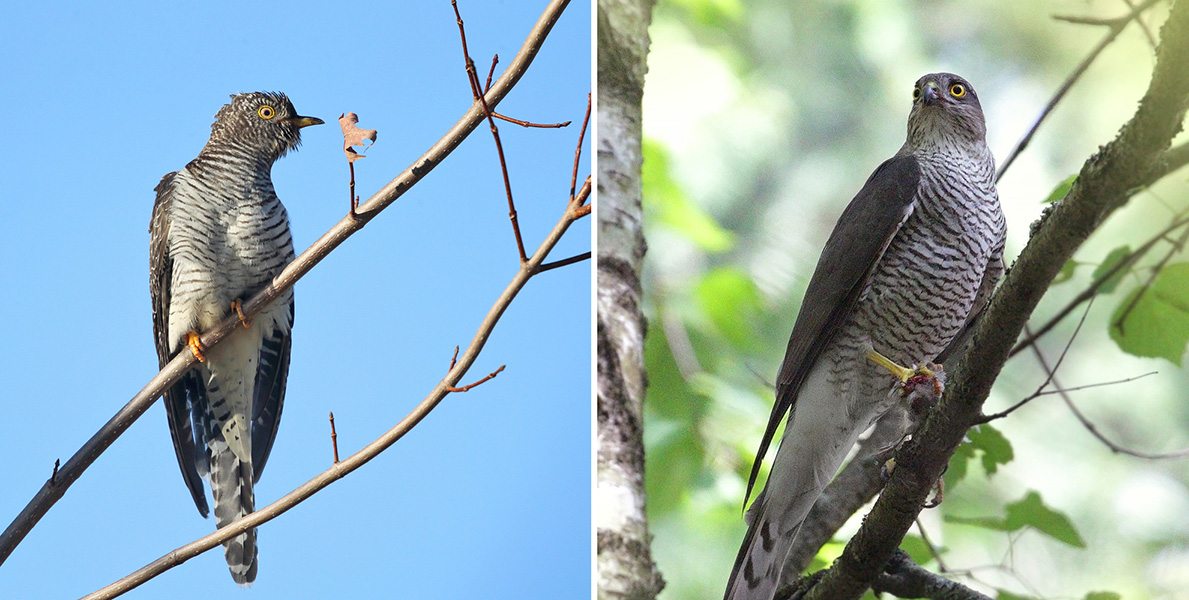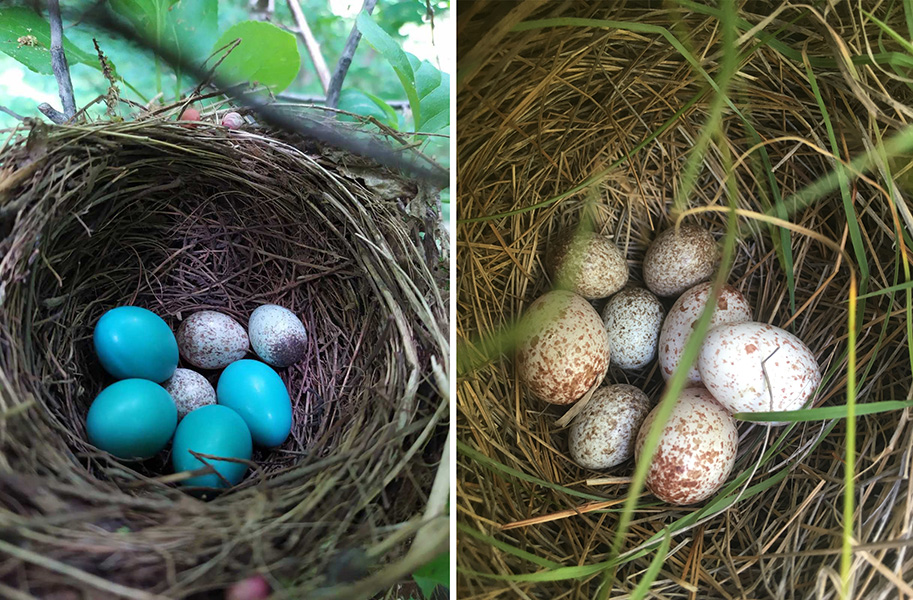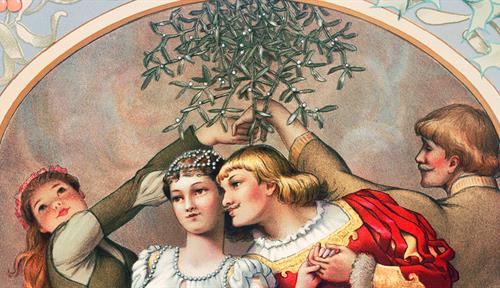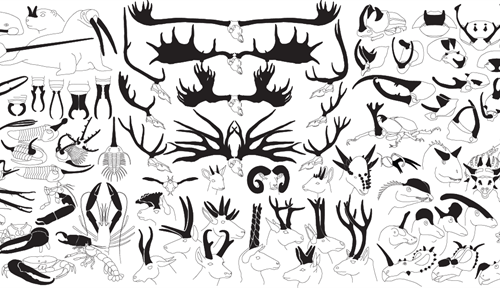Are you my baby? The clever ways that brood parasites trick other birds
Cuckoos, cowbirds and other species outsource their parental duties. Scientists are uncovering new twists in this sneaky — and often treacherous — game of survival.
Support sound science and smart stories
Help us make scientific knowledge accessible to all
Donate today
Parenting can be lots of work for a bird: all that flying back and forth transporting grubs and insects to a nest of demanding young. But some birds manage to forgo caring for their chicks — while still ensuring they’re well looked after. These birds lay their eggs in the nests of other birds that unknowingly adopt the hatchlings, nourishing and protecting them as their own.
Only about 1 percent of all bird species resort to this sneaky family planning method, called obligate brood parasitism, but it has evolved at least seven separate times in the history of birds and is a way of life for at least 100 species. Since some brood parasites rely on several different bird species as foster parents, more than a sixth of all species in the avian world care for chicks that aren’t their own at some point.
Throughout the millennia, these trespassers have evolved ingenious ways to fool the hosts, and the hosts have developed equally clever ways to protect themselves and their own. At each stage of the nesting cycle, it’s a game of subterfuge that plays out in color, sound and behavior.
“There’s always something new — it’s like, ‘Oh, man, this group of birds went down a slightly different pathway,’” says behavioral ecologist Bruce Lyon of the University of California, Santa Cruz, who studies the black-headed duck (Heteronetta atricapilla), the sole obligate parasitic duck species.
While many mysteries remain, new research is constantly unearthing just how intense this evolutionary tug-of-war can get.

Some brood parasites have evolved to look like predators, which can scare a potential host bird, prompting it to fly off and leave the nest open to intruders. The plumage of this parasitic common cuckoo (left) bears a striking resemblance to the Eurasian sparrowhawk (right), a predator of woodland birds.
CREDITS: TOM MURRAY (LEFT), TAT’YANA VYSOTSKAYA (RIGHT) / iNATURALIST
From mimicry to murder
Breaching another bird’s nest is the parasite’s first move. Sometimes this is accomplished via deception: The female cuckoo-finch (Anomalospiza imberbis), for example, has evolved to look like a harmless, non-parasitic bird that lives in the same area, allowing it to sneak into host nests unchallenged. The common cuckoo (Cuculus canorus) takes another tack — it has evolved to mimic the look of a predatory raptor, prompting host mothers to fly off in fear and leave their nest unattended.
But sometimes, parasites get to the party too late and they don’t find nests into which they can plop their eggs; the eggs are almost ready to crack open, or everybody’s already hatched. In this case, they may fling out chirping chicks and sometimes will ransack the nest. This can prompt the hosts to make new nests from scratch, giving the intruder a brand-new nest to parasitize.
Scientists had some evidence of this strategy — called farming, because the parasites “farm” new nests — but recently, they caught birds in the murderous act and watched them parasitize the new nest as well.
Ornithologist Jinggang Zhang was running a long-term study with Daurian redstarts (Phoenicurus auroreus) in northeastern China. In one nestbox, two Daurian redstarts were caring for a family of seven, and when the chicks were just 5 days old, a common cuckoo showed up and, in less than a minute, plucked all of the newborns and chucked them to their deaths. “I was surprised and confused,” says Zhang. Two days later, the resilient redstart parents made themselves a new nest about 15 feet from the murder scene, and the cuckoo laid one of its eggs inside it. It’s the first time that farming of nestlings had been documented on camera, says Zhang, who recently reported the event in Ecology and Evolution.
Host birds, of course, have evolved strategies to defend their nest and brood. Some sit tight and guard their nests, others may attack the intruder — yellow warblers even have a unique bird call that warns nearby birds of a parasite in the neighborhood.
American robins are exceptionally good at knowing their own eggs — and will get rid of eggs that don’t belong, a defensive tactic seen in this short video.
CREDIT: ANALÍA V. LÓPEZ
And some hosts may try to totally preempt any parasitism risk. Behavioral ecologist Iliana Medina Guzman of the University of Melbourne theorizes that pressure from parasites has led some hosts, like the yellow-rumped thornbill (Acanthiza chrysorrhoa), to breed earlier than many of their peers, thus avoiding breeding at the same time as their parasite.
Breeding earlier, says Zhang, might also have spurred the evolution of farming — as a counterstrategy to finding nests already full.
Mimicking eggs and spotting imposters
When a parasite makes it into another family’s nest, it usually will nudge out one or two of the host’s eggs to make space for its own. And while nonparasitic birds take about 20 minutes to lay an egg, parasites like cuckoos and honeyguides are fast. “They swoop into the nest and they squeeze out an egg in three seconds flat,” says Rosalyn Gloag, an evolutionary biologist from the University of Sydney. Some parasites have also evolved thicker-shelled eggs that are less likely to crack when hastily dropped.
And there are parasites that go the extra mile to ensure their eggs aren’t detected and rejected: They mimic the look of the eggs of their hosts. In some birds, such as cuckoo finches, this egg coloration trait is passed from mothers to daughters: Female cuckoo finches mimic the eggs that their mother mimicked. So some cuckoo finches lay blue eggs mottled with brown, while another may specialize in eggs with red speckles, depending on which host nest they grew up in.
Still, these tricks don’t always work, says ornithologist Mark Hauber of the Graduate Center of the City University of New York. He has long been researching what makes some birds better than others at recognizing intruders’ eggs, and his data suggest that some hosts can eject eggs that are off in terms of color and size.
Other hosts, like weaver finches and warblers, have perfected laying eggs speckled with signature colors, patterns and squiggles that seem to be impossible to mimic and are easier to tell apart from the intruders’.
“There’s something about the markings, the entropy of the spotting, that is more consistent within the host’s own egg,” says Hauber. It’s so precise that he hasn’t been able to replicate the patterns in his lab despite making hundreds of artificially speckled eggs.

The eggs of a brood parasite often look nothing like the eggs of its host bird, as seen here with the speckled cowbird eggs among the blue eggs of an American robin (left). But the cowbird eggs are harder to distinguish from that of the Eastern Meadowlark (right) another host species.
CREDITS: MARK HAUBER (LEFT), SARAH K. WINNICKI (RIGHT)
New research by Hauber suggests that older birds with more breeding experience are better than younger birds at telling foreign eggs from their own. Hauber introduced fake, 3D-printed eggs into the nests of American robins (Turdus migratorius); the eggs were painted robin blue or the beiges and browns of a parasitic cowbird’s egg. Monitoring the robins revealed that hosts can learn and become better at rejecting intruder eggs from their nests, Hauber and colleagues reported in 2023.
Outgrowing, or outlasting, the competition
Once the eggs are safely in the nest, many parasites hatch earlier than their foster siblings, giving the invaders a head start.
Australian bronze cuckoos, for instance, hatch two days earlier and emerge looking just like their nestmates (had the latter not been shoved out of the nest as eggs). They barely arouse suspicion.
But most bird species don’t need to fool their new guardians with subtle looks. The primary way that birds recognize their young is just “Is it my nest?” Gloag says. “We’re like, ‘How can those parents not recognize that that chick is not their own chick? It’s five times the size of them!’”
Intruder chicks also trick their parents into feeding them more than their siblings — that’s how they get the real advantage. In a nest where everybody is related, there is a benefit to everyone surviving — shared genes mean that individuals aren’t incentivized to be as greedy, says Gloag. It’s different for parasites sharing a nest with total strangers.
And for a wide range of other bird species, faking being really hungry, and crying and begging a lot, does the job, says ornithologist Rafaela Vitti Ferneda, a master’s student at São Paulo State University in Brazil.
Ferneda spent two years investigating whether pale-breasted thrushes (Turdus leucomelas) realize they are feeding intruding nestlings of shiny cowbirds (Molothrus bonariensis). Deep down, she expected that the parents could recognize their own chicks. But she was surprised when it didn’t look like it. The parasitic cowbirds were fed more quickly and more frequently than the thrushes, and the thrushes didn’t even try to keep up with the intruders’ level of begging, Ferneda reported in June 2024. That cowbird melodrama — extra squawking, begging and tilting of the head — may be what allows it to parasitize a wide variety of host species without specialized looks or sounds, Ferneda says.
Terrible though brood parasitism may sound, it is not a calamity for the exploited species. “A parasite will be really annoying and it might destroy a reproductive attempt,” says William Feeney, a behavioral ecologist at Doñana Biological Station in Spain and coauthor of a look at coevolution between parasites and their hosts in the Annual Review of Ecology, Evolution, and Systematics. “But birds typically have more than one of them in their lives.”
The relationship between cowbirds and thrushes, honeyguides and swallows, or cuckoos and their various and diverse hosts is one of constant change. Parasites and hosts are waging a war through evolutionary time, such that what scientists see now is just a snapshot in a longstanding battle. And somewhere in there, the birds are finding balance: tactical tradeoffs that allow both parasite and host to persist.
10.1146/knowable-100224-1
TAKE A DEEPER DIVE | Explore Related Scholarly Articles






